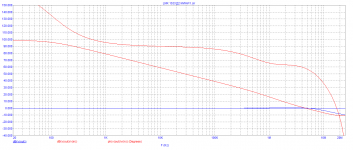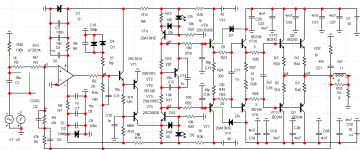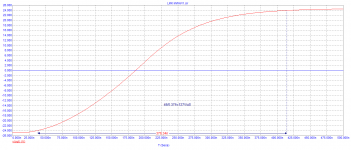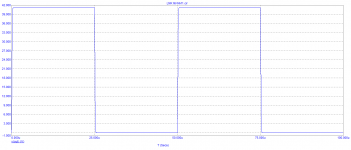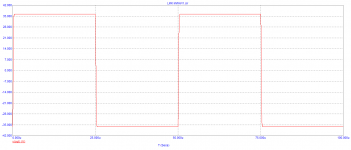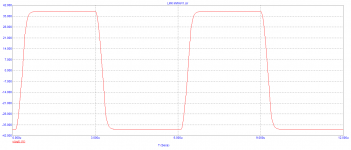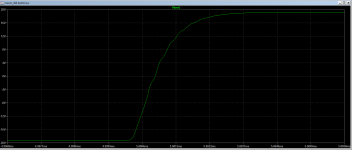HexFet version of the last Crest-like amp (buffered) is even faster than LatFet version.
I think it's very promising.
Attached results for 1kHz and 10kHz input.
Slew rate at least 100V/us
I think it's very promising.
Attached results for 1kHz and 10kHz input.
Slew rate at least 100V/us
Attachments
-
crest.dec14.buf.hex.asc10.4 KB · Views: 112
-
 crest.buf.hexfet.rise_time.png15.1 KB · Views: 203
crest.buf.hexfet.rise_time.png15.1 KB · Views: 203 -
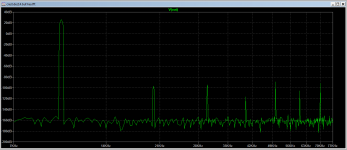 crest.buf.hexfet.fft_10khz.png22.7 KB · Views: 140
crest.buf.hexfet.fft_10khz.png22.7 KB · Views: 140 -
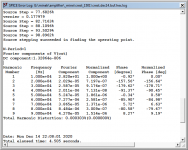 crest.buf.hexfet.thd_10khz.png24.8 KB · Views: 258
crest.buf.hexfet.thd_10khz.png24.8 KB · Views: 258 -
 crest.buf.hexfet.fft_1khz.png24.8 KB · Views: 261
crest.buf.hexfet.fft_1khz.png24.8 KB · Views: 261 -
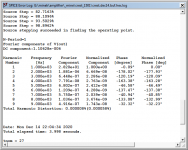 crest.buf.hexfet.thd_1khz.png24.3 KB · Views: 318
crest.buf.hexfet.thd_1khz.png24.3 KB · Views: 318 -
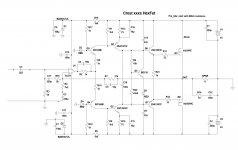 crest.buf.hexfet.schematic.jpg198.5 KB · Views: 342
crest.buf.hexfet.schematic.jpg198.5 KB · Views: 342
C9/C13 should be increased to 100pF to handle capacitive loads.
This might slow it down a little bit.
This might slow it down a little bit.
An attempt to increase the rate of voltage rise and the amplitude of the meander at the output of the amplifier was successful. Judge for yourself. In the archive, the dependence of kg on the frequency of the input signal. 40hz, 200khz, 2kHz and 20kHz.
The archive with the MS-12 model is attached
The archive with the MS-12 model is attached
Attachments
Last edited:
The amplitude of the output square is 30Vpp (30V peak-to-peak) in your sim.
I was testing with INPUT square wave -1...+1 V,
which generates OUTPUT at -25...+25 V (50Vpp)
Most of troubles with square waves happens with higher amplitude of the INPUT/OUTPUT signal.
Most of LMK-style amps I simmed here, were UNABLE to handle square waves correctly with output at 50Vpp, unless
they were slowed down to 15V/us.
I was testing with INPUT square wave -1...+1 V,
which generates OUTPUT at -25...+25 V (50Vpp)
Most of troubles with square waves happens with higher amplitude of the INPUT/OUTPUT signal.
Most of LMK-style amps I simmed here, were UNABLE to handle square waves correctly with output at 50Vpp, unless
they were slowed down to 15V/us.
Last edited:
Supply voltage+/-32-35 in my models. I'll change it to +/-45 and show it.
Лепота
Лепота
Attachments
Last edited:
>Supply voltage+/-32-35 in my models. I'll change it to +/-45 and show it
With this supply voltage (+/-35V), it still should be able to do 50Vpp at the output (-25...+25 V)
Also, not sure why your output for square waves shows range from 0V to 30V.
It should show from -15V to 15V. Your square wave is positive only? Not symmetrical?
If it is so - that's a problem... It should be symmetrical (positive/negative).
Is the amp clipping negative half, or your input is positive-only?
Look at my square wave in post #882 (last picture). It's symmetrical, and ranges from -25V ... + 25V (50Vpp)
With this supply voltage (+/-35V), it still should be able to do 50Vpp at the output (-25...+25 V)
Also, not sure why your output for square waves shows range from 0V to 30V.
It should show from -15V to 15V. Your square wave is positive only? Not symmetrical?
If it is so - that's a problem... It should be symmetrical (positive/negative).
Is the amp clipping negative half, or your input is positive-only?
Look at my square wave in post #882 (last picture). It's symmetrical, and ranges from -25V ... + 25V (50Vpp)
Last edited:
In the model, the signal is set to only one polarity .For ease of analysis.When the input capacitor is closed, both half-waves can be seen . i'm used to watching on one half-wave.Just a habit.
the desired image . And at a higher frequency
Attachments
Last edited:
Changed the loop gain of the nested oos. R10- 12k /
The distortion didn't change.the speed and dynamics have changed for the better .
The distortion didn't change.the speed and dynamics have changed for the better .
After quick test:
for my square waves test, rise time is 2us on 50Vpp, so Slew Rate is 25V/us.
Will do more testing, and post the images.
Correction: Actually it's not even 50Vpp, but 40Vpp, so it's pretty much the same speed as standard LMK
Image attached.
for my square waves test, rise time is 2us on 50Vpp, so Slew Rate is 25V/us.
Will do more testing, and post the images.
Correction: Actually it's not even 50Vpp, but 40Vpp, so it's pretty much the same speed as standard LMK
Image attached.
Attachments
Last edited:
What exactly is your rise time? Hard to tell from your square plot. Can you zoom it to show on rise slope?
I don't know. Here everything is already on the edge.It is necessary to make a printed circuit board with very low distortion and high slew rate, greater overall gain.
Can you zoom your square wave graph to show the rise slope in more detail, so we can read microseconds on the X axis, and estimate rise time?
To me it looks like it's still the same speed as normal LMK/Wiederhold.
But I'm going to play with my sim a little bit, to make it as close to your schematic as possible.
I'm testing with drivers + HexFet outputs - they seem to be faster than LetFets...
Update: attached my latest schematic I'm using for simming.
To me it looks like it's still the same speed as normal LMK/Wiederhold.
But I'm going to play with my sim a little bit, to make it as close to your schematic as possible.
I'm testing with drivers + HexFet outputs - they seem to be faster than LetFets...
Update: attached my latest schematic I'm using for simming.
Attachments
Last edited:
- Home
- Amplifiers
- Solid State
- Unusual amp from 1987

